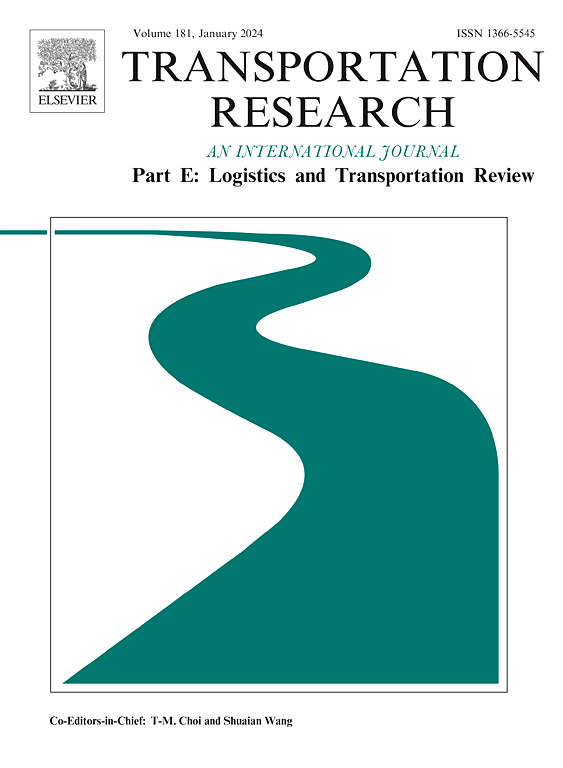更新需求和质量信息的两阶段最佳购置和再制造决策
IF 8.3
1区 工程技术
Q1 ECONOMICS
Transportation Research Part E-Logistics and Transportation Review
Pub Date : 2024-10-22
DOI:10.1016/j.tre.2024.103823
引用次数: 0
摘要
逆向物流中的再制造活动因其明显的经济和环境效益而具有重要的理论和实践价值。然而,瞬息万变的市场需求和不确定的退货质量使得再制造生产管理面临巨大挑战。以往的研究主要集中在基于静态的市场需求和对型芯质量的充分了解来确定最优的再制造决策,而忽略了需求信息的动态变化和质量分布情况的不完全估计。因此,本文提出了一种需求和质量信息更新的两阶段获取和再制造方法。在第一阶段,再制造企业根据预测的需求和估计的质量分布制定收购和再制造决策。根据更新的市场需求和第一阶段的结果,再制造企业调整第二阶段的最优决策,以实现利润最大化。有鉴于此,本文为收购和再制造问题建立了一个两阶段非线性数学模型。基于情景分析方法和多元优化理论,得到了每个阶段的最优策略。为了评估所提出方法的有效性,进行了数值实验、参数敏感性分析以及与单阶段购置和再制造方法的对比分析。结果表明,考虑到需求和质量信息更新的两阶段获取和再制造方法对外部变化的适应性更强。与单阶段方法相比,采用两阶段方法的再制造企业可实现 6 %~11 % 的预期利润增长。此外,两阶段法的效果受再订货点的影响很大,存在一个最佳再订货点,可使再制造企业的总利润最大化。我们的研究为逆向物流中的不确定性研究做出了贡献,为再制造企业的运营决策提供了新的见解。本文章由计算机程序翻译,如有差异,请以英文原文为准。
Two-stage optimal acquisition and remanufacturing decisions with demand and quality information updating
Remanufacturing activities in reverse logistics hold significant theoretical and practical value for their obvious economic and environmental benefits. However, the ever-changing market demand and the uncertain quality of returned items make the management of remanufacturing production highly challenging. Previous studies have mainly focused on determining the optimal remanufacturing decisions based on static market demand and full knowledge of cores quality, while overlooking the dynamic changes in demand information and the imperfect estimation of quality distribution case. Therefore, this paper proposes a two-stage acquisition and remanufacturing method with demand and quality information updating. In the first stage, the remanufacturer formulates acquisition and remanufacturing decisions based on predicted demand and estimated quality distribution. According to updated market demand and the results of the first-stage, the remanufacturer adjusts the optimal decisions for the second stage to maximize profit. In light of this, a two-stage nonlinear mathematical model is established for the acquisition and remanufacturing problem. Based on the scenario analysis method and multivariate optimization theory, optimal strategies for each stage are obtained. To assess the effectiveness of the method put forward, numerical experiments, sensitivity analysis of parameters, and comparative analysis with single-stage acquisition and remanufacturing method are conducted. The results show that the two-stage acquisition and remanufacturing method that accounts for demand and quality information updating can demonstrate greater adaptability to external changes. Compared to the single-stage method, the remanufacturer adopting the two-stage method can achieve an expected profit growth of 6 %∼11 %. Additionally, the effectiveness of the two-stage method is significantly influenced by the reorder point, and there exists an optimal reorder point to maximize the total profit of the remanufacturer. Our research contributes to the uncertainty research in reverse logistics, providing new insights for operational decision-making in remanufacturing enterprises.
求助全文
通过发布文献求助,成功后即可免费获取论文全文。
去求助
来源期刊
CiteScore
16.20
自引率
16.00%
发文量
285
审稿时长
62 days
期刊介绍:
Transportation Research Part E: Logistics and Transportation Review is a reputable journal that publishes high-quality articles covering a wide range of topics in the field of logistics and transportation research. The journal welcomes submissions on various subjects, including transport economics, transport infrastructure and investment appraisal, evaluation of public policies related to transportation, empirical and analytical studies of logistics management practices and performance, logistics and operations models, and logistics and supply chain management.
Part E aims to provide informative and well-researched articles that contribute to the understanding and advancement of the field. The content of the journal is complementary to other prestigious journals in transportation research, such as Transportation Research Part A: Policy and Practice, Part B: Methodological, Part C: Emerging Technologies, Part D: Transport and Environment, and Part F: Traffic Psychology and Behaviour. Together, these journals form a comprehensive and cohesive reference for current research in transportation science.

 求助内容:
求助内容: 应助结果提醒方式:
应助结果提醒方式:


